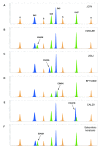A SNaPshot assay for the rapid and simple detection of four common hotspot codon mutations in the PIK3CA gene
- PMID: 19402901
- PMCID: PMC2683860
- DOI: 10.1186/1756-0500-2-66
A SNaPshot assay for the rapid and simple detection of four common hotspot codon mutations in the PIK3CA gene
Abstract
Background: Activating mutations in the PIK3CA gene have been identified in a variety of human malignancies and are commonly detected in hotspot codons located in the helical and kinase domains in exons 9 and 20. Existing methodologies for the detection of PIK3CA mutations are time-consuming and/or expensive. In the present study we describe the first application of a PIK3CA SNaPshot assay to the screening of frequent mutations in these exons.
Findings: A SNaPshot assay for the simultaneous detection of four frequent PIK3CA hotspot mutations (E542K, E545G, E545K and H1047R) has been developed and evaluated. The assay combines multiplex PCR amplification with a multiplex primer extension assay to allow targeted detection of all four mutations in one reaction. The method was tested using samples that had previously been analysed for mutations by high-resolution melting analysis and sequencing. All mutations detected were concordant and no false positive results were obtained. Sensitivity tests showed that the SNaPshot assay could detect mutant DNA when it represents 5-10% of the total DNA present. The application of the method to the analysis of DNAs extracted from formalin-fixed paraffin-embedded samples was also demonstrated.
Conclusion: The SNaPshot assay described here offers a fast, sensitive, inexpensive and specific approach to the analysis of frequent PIK3CA mutations in both fresh and archival patient samples.
Figures


References
-
- Philp AJ, Campbell IG, Leet C, Vincan E, Rockman SP, Whitehead RH, Thomas RJ, Phillips WA. The phosphatidylinositol 3'-kinase p85alpha gene is an oncogene in human ovarian and colon tumors. Cancer Res. 2001;61:7426–7429. - PubMed
LinkOut - more resources
Full Text Sources
Other Literature Sources
Miscellaneous

